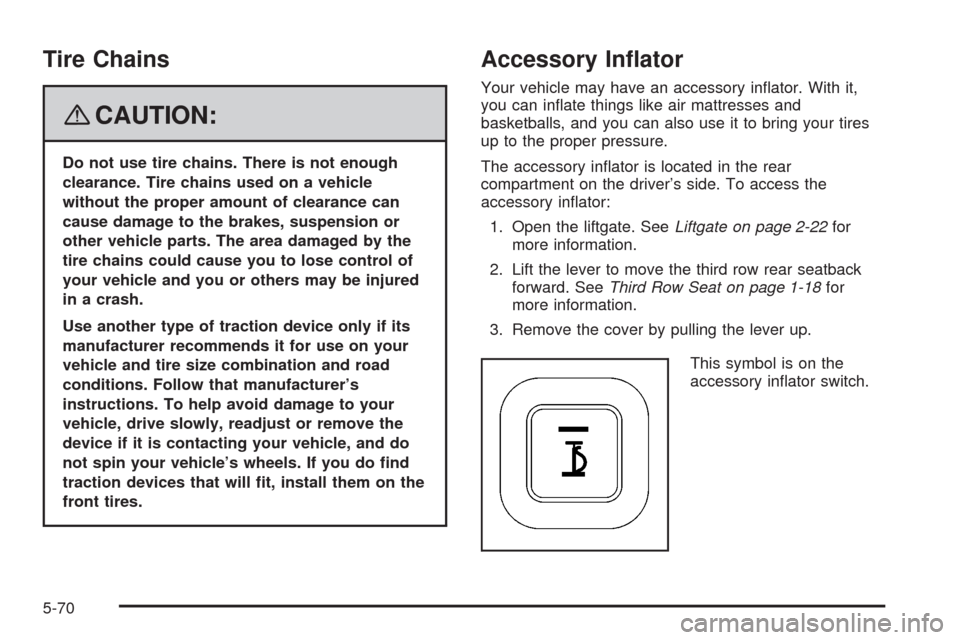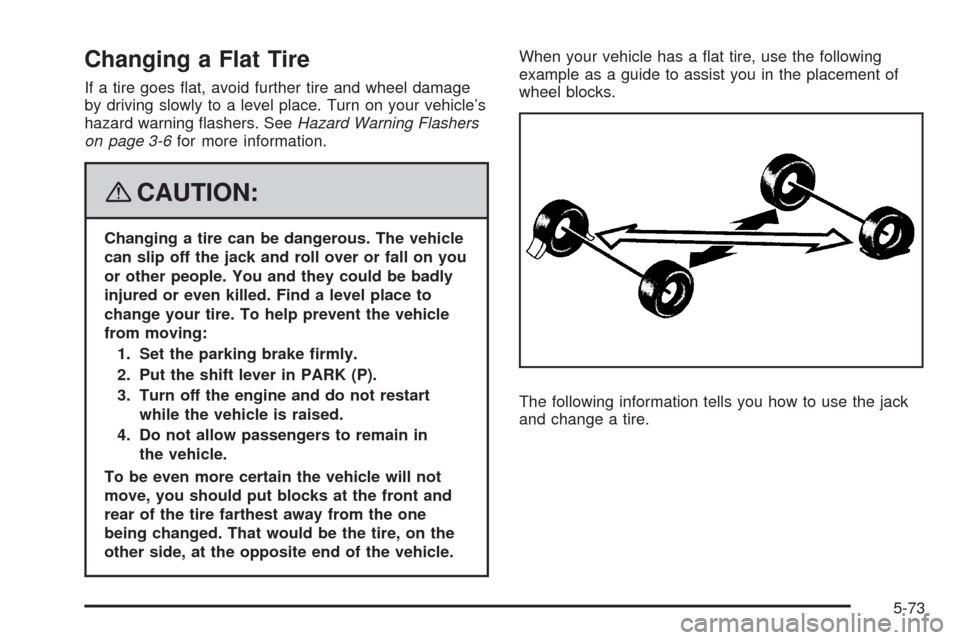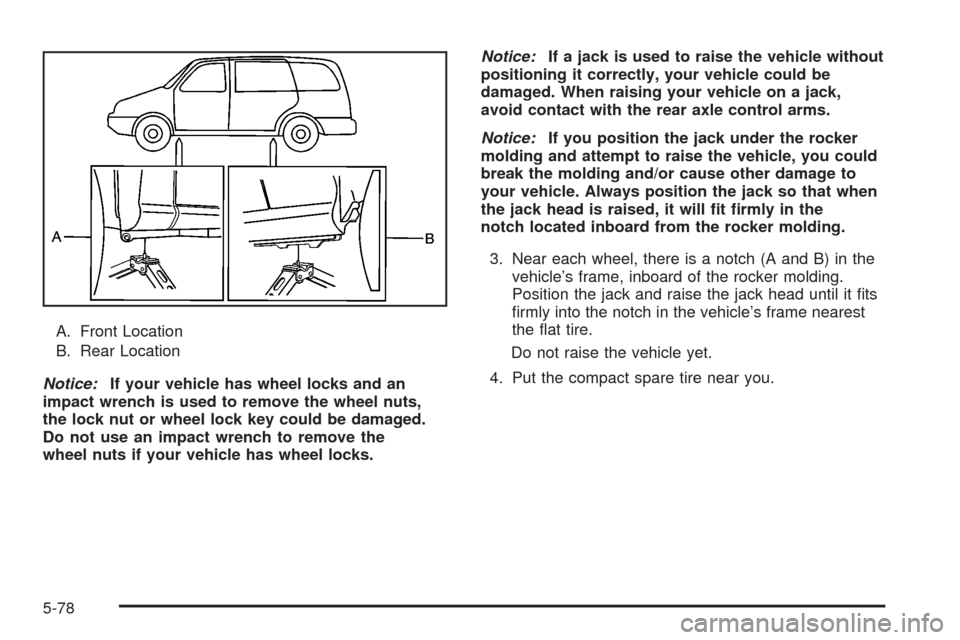Page 390 of 476

Tire Chains
{CAUTION:
Do not use tire chains. There is not enough
clearance. Tire chains used on a vehicle
without the proper amount of clearance can
cause damage to the brakes, suspension or
other vehicle parts. The area damaged by the
tire chains could cause you to lose control of
your vehicle and you or others may be injured
in a crash.
Use another type of traction device only if its
manufacturer recommends it for use on your
vehicle and tire size combination and road
conditions. Follow that manufacturer’s
instructions. To help avoid damage to your
vehicle, drive slowly, readjust or remove the
device if it is contacting your vehicle, and do
not spin your vehicle’s wheels. If you do �nd
traction devices that will �t, install them on the
front tires.
Accessory In�ator
Your vehicle may have an accessory in�ator. With it,
you can in�ate things like air mattresses and
basketballs, and you can also use it to bring your tires
up to the proper pressure.
The accessory in�ator is located in the rear
compartment on the driver’s side. To access the
accessory in�ator:
1. Open the liftgate. SeeLiftgate on page 2-22for
more information.
2. Lift the lever to move the third row rear seatback
forward. SeeThird Row Seat on page 1-18for
more information.
3. Remove the cover by pulling the lever up.
This symbol is on the
accessory in�ator switch.
5-70
Page 392 of 476

If a Tire Goes Flat
It is unusual for a tire to blowout while you are driving,
especially if you maintain your vehicle’s tires properly.
If air goes out of a tire, it is much more likely to leak out
slowly. But if you should ever have a blowout, here
are a few tips about what to expect and what to do:
If a front tire fails, the �at tire creates a drag that pulls
the vehicle toward that side. Take your foot off the
accelerator pedal and grip the steering wheel �rmly.
Steer to maintain lane position, and then gently brake to
a stop well out of the traffic lane.
A rear blowout, particularly on a curve, acts much like a
skid and may require the same correction you would
use in a skid. In any rear blowout remove your foot from
the accelerator pedal. Get the vehicle under control
by steering the way you want the vehicle to go. It may
be very bumpy and noisy, but you can still steer.
Gently brake to a stop, well off the road if possible.{CAUTION:
Lifting a vehicle and getting under it to do
maintenance or repairs is dangerous without
the appropriate safety equipment and training.
The jack provided with your vehicle is
designed only for changing a �at tire. If it is
used for anything else, you or others could be
badly injured or killed if the vehicle slips off
the jack. Use the jack provided with your
vehicle only for changing a �at tire.
If a tire goes �at, the next part shows how to use the
jacking equipment to change a �at tire safely.
5-72
Page 393 of 476

Changing a Flat Tire
If a tire goes �at, avoid further tire and wheel damage
by driving slowly to a level place. Turn on your vehicle’s
hazard warning �ashers. SeeHazard Warning Flashers
on page 3-6for more information.
{CAUTION:
Changing a tire can be dangerous. The vehicle
can slip off the jack and roll over or fall on you
or other people. You and they could be badly
injured or even killed. Find a level place to
change your tire. To help prevent the vehicle
from moving:
1. Set the parking brake �rmly.
2. Put the shift lever in PARK (P).
3. Turn off the engine and do not restart
while the vehicle is raised.
4. Do not allow passengers to remain in
the vehicle.
To be even more certain the vehicle will not
move, you should put blocks at the front and
rear of the tire farthest away from the one
being changed. That would be the tire, on the
other side, at the opposite end of the vehicle.When your vehicle has a �at tire, use the following
example as a guide to assist you in the placement of
wheel blocks.
The following information tells you how to use the jack
and change a tire.
5-73
Page 396 of 476

3. Tilt the retainer at the end of the cable to remove
the compact spare tire, so it can be pulled up
through the wheel opening.
The hoist is used to store a full-size or a �at road tire
under the vehicle. SeeStoring a Flat or Spare Tire
and Tools on page 5-86for more information.
4. Remove the compact spare tire from the cable.
If the compact spare tire will not lower, check under the
vehicle to see if the tire is hanging loose and the
cable end and spring under the wheel plate are missing.
If so, the secondary latch system is engaged. See
Secondary Latch System on page 5-83.
To continue changing the �at tire, seeRemoving the
Flat Tire and Installing the Spare Tire on page 5-76.
Removing the Flat Tire and
Installing the Spare Tire
Your vehicle may have aluminum wheels. If so, you will
see exposed stainless steel wheel nuts. Use the
wheel wrench to loosen all of the wheel nuts. Do not
remove them yet.
Your vehicle may have steel wheel covers. To remove
the wheel covers and wheel nut caps, loosen the
plastic nut caps with the wheel wrench in a
counterclockwise direction. If needed, �nish loosening
them with your �ngers. The plastic nut caps will not
come off.
Use the �at end of the wheel wrench and pry along the
edge of the cover until it comes off. The edge of the
wheel cover could be sharp, so do not try to remove it
with your bare hands. Do not drop the cover or lay
it face down, as it could become scratched or damaged.
5-76
Page 397 of 476
Store the wheel cover securely in the rear of the
vehicle until you have the �at tire repaired or replaced.
Once the wheel cover has been removed, use the
following procedure to remove the �at tire and install
the spare tire.
1. Do a safety check is done before proceeding.
SeeChanging a Flat Tire on page 5-73for more
information.2. Loosen the wheel nuts
using the folding
wrench, but do not
remove them.
Turn the handle counterclockwise about
180 degrees, then �ip the handle back to the
starting position. This avoids taking the wrench off
the lug nut for each turn.
5-77
Page 398 of 476

A. Front Location
B. Rear Location
Notice:If your vehicle has wheel locks and an
impact wrench is used to remove the wheel nuts,
the lock nut or wheel lock key could be damaged.
Do not use an impact wrench to remove the
wheel nuts if your vehicle has wheel locks.Notice:If a jack is used to raise the vehicle without
positioning it correctly, your vehicle could be
damaged. When raising your vehicle on a jack,
avoid contact with the rear axle control arms.
Notice:If you position the jack under the rocker
molding and attempt to raise the vehicle, you could
break the molding and/or cause other damage to
your vehicle. Always position the jack so that when
the jack head is raised, it will �t �rmly in the
notch located inboard from the rocker molding.
3. Near each wheel, there is a notch (A and B) in the
vehicle’s frame, inboard of the rocker molding.
Position the jack and raise the jack head until it �ts
�rmly into the notch in the vehicle’s frame nearest
the �at tire.
Do not raise the vehicle yet.
4. Put the compact spare tire near you.
5-78
Page 400 of 476
6. Raise the vehicle by turning the folding wrench
clockwise in the jack. Raise the vehicle far enough
off the ground so there is enough room for the
compact spare tire to �t under the wheel well.
7. Remove all the wheel nuts and take off the �at tire.
{CAUTION:
Rust or dirt on a wheel, or on the parts to
which it is fastened, can make wheel nuts
become loose after time. The wheel could
come off and cause an accident. When you
change a wheel, remove any rust or dirt from
places where the wheel attaches to the vehicle.
In an emergency, you can use a cloth or a
paper towel to do this; but be sure to use a
scraper or wire brush later, if needed, to get all
the rust or dirt off. SeeChanging a Flat Tire
on page 5-73.
5-80
Page 401 of 476
{CAUTION:
Never use oil or grease on studs or nuts.
Because the nuts might come loose. The
vehicle’s wheel could fall off, causing a crash.
8. Remove any rust or dirt
from the wheel bolts,
mounting surfaces
and spare wheel.9. Install the compact
spare tire and put the
wheel nuts back
on with the rounded
end of the nuts toward
the wheel.
Tighten each nut by hand until the wheel is held
against the hub.
5-81